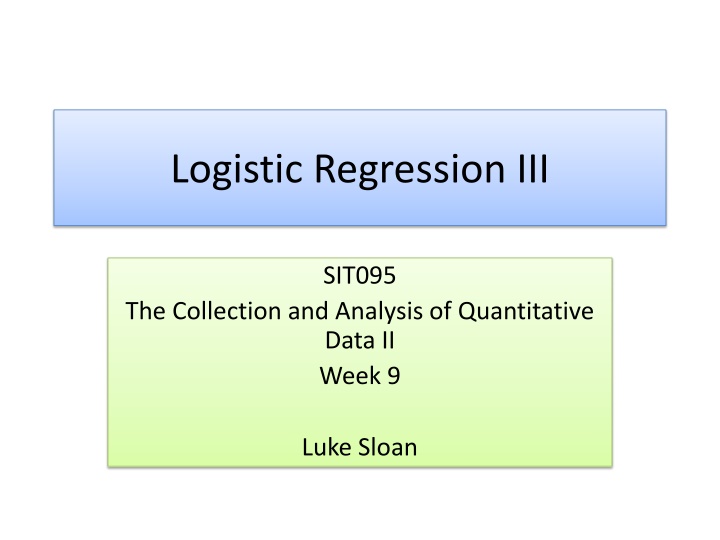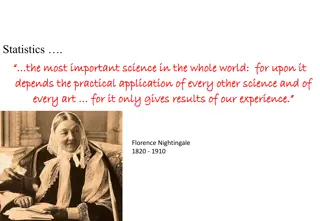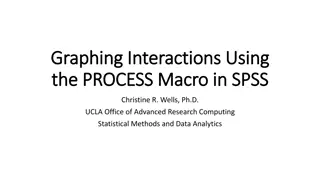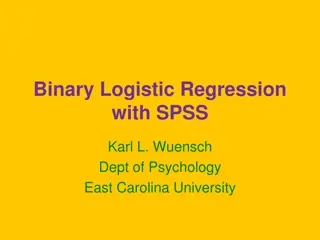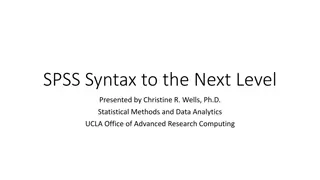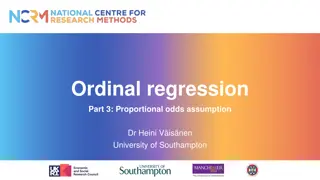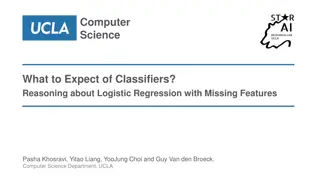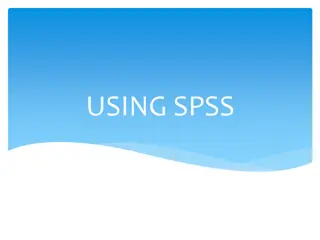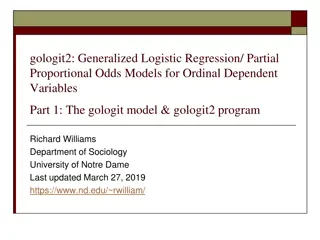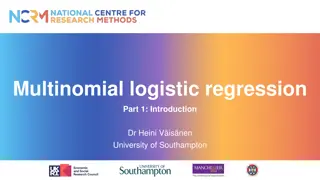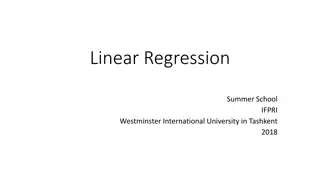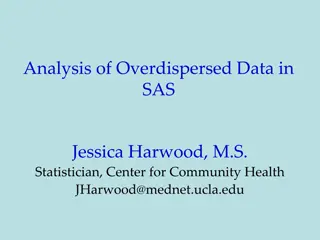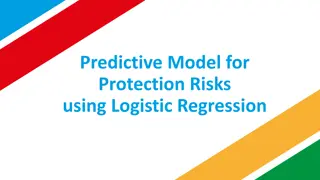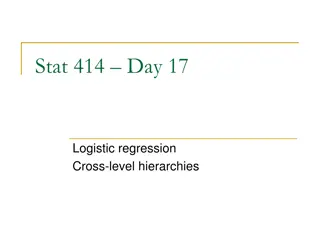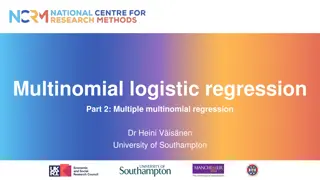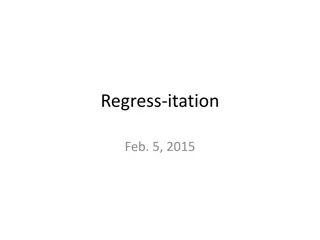Multinomial Logistic Regression in SPSS for Education Level Analysis
This content discusses multinomial logistic regression in SPSS, specifically focusing on analyzing education levels with a categorical dependent variable. It covers how to select a reference category, interpret results, and make comparisons among different educational qualifications. The examples provided offer insights into running and interpreting multinomial logistic models effectively.
Download Presentation

Please find below an Image/Link to download the presentation.
The content on the website is provided AS IS for your information and personal use only. It may not be sold, licensed, or shared on other websites without obtaining consent from the author.If you encounter any issues during the download, it is possible that the publisher has removed the file from their server.
You are allowed to download the files provided on this website for personal or commercial use, subject to the condition that they are used lawfully. All files are the property of their respective owners.
The content on the website is provided AS IS for your information and personal use only. It may not be sold, licensed, or shared on other websites without obtaining consent from the author.
E N D
Presentation Transcript
Logistic Regression III SIT095 The Collection and Analysis of Quantitative Data II Week 9 Luke Sloan
Introduction Recap Last Week Workshop Feedback Multinomial Logistic Regression in SPSS Model Interpretation In Class Exercise Writing-Up Summary
Recap Last Week Variable selection Binary logistic regression in SPSS Model interpretation Intuitive results?
Workshop Feedback TASK: To run and interpret a binary logistic regression model with Sex as the dependent variable using your own choice of independent variables Were your models successful? Did you have any problems or issues? Did you find anything interesting (interpretation of odds ratios)? Did you have difficulty in interpretation? TODAY: I will show you how to run and interpret a multinomial logistic model in SPSS. I will use a different dependent variable ( edlev7 )and the same dataset.
Multinomial Logistic Regression in SPSS I Very similar to binary logistic regression For a categorical dependent variable with more than two categories edlev7 asks for the highest educational qualification of a respondent and has three categories: Higher Education , Other Qualification and None One of these categories has to be designated a reference category to which the others will be compared E.g. if None is the reference category respondents who had Higher Education qualifications were more likely to be female (odds increase of 2.3) than respondents with no qualifications Respondents who had other qualifications were less likely to be female (odds decrease of 0.45) than respondent with no qualifications It is not possible to compare groups that are not the reference category i.e. we cannot draw comparisons between Higher Education and Other Qualification directly
Multinomial Logistic Regression in SPSS II Deciding on a reference category should be an informed decision what do we want to compare? Education Level - 2000 (3 groups) As a rule of thumb, the reference category should be the most populated response (highest frequency), but this can be over- ruled by your research agenda Cumulative Percent Frequency Percent Valid Percent Valid HIGHER EDUCAT OTHER QUAL NONE Total NEV WENT SCH NA AGEOUT,MSPR System Total 2015 2826 1614 6455 16 24.5 34.4 19.6 78.5 31.2 43.8 25.0 100.0 31.2 75.0 100.0 Missing .2 .0 4 1745 21.2 1 .0 1766 8221 21.5 100.0 Total In this case I am going to use Other Qualification for several reasons: largest group, median point and interesting from a theoretical perspective (difference between Other Qual and Higher Education might question value of studying at university
Multinomial Logistic Regression in SPSS III You still need to select your variables carefully Consider hypotheses, frequencies, recoding, relationships and multicolinearity My variables (including recodes): manual2 (non-manual/manual) ethnic2 (white/non-white) marital2 (married/cohabiting/single/widowed/divorced or separated) seefrnd2 (weekly/monthly/less than monthly/not in last year) cntctmp (yes/no) age (in years) alcdrug2 (very big problem/fairly big problem/minor problem/not a problem/happens but is not a problem) influence2 (yes/no) Excluded due to multicolinearity could be interesting
Multinomial Logistic Regression in SPSS IV 1) To begin, go to Analyze , Regression and select Multinomial Logistic 2) Your dependent goes here 3) Click on Reference Category By default SPSS will use the last category in your independent categorical variables as the reference category
Multinomial Logistic Regression in SPSS V You need to tell SPSS which response for the dependent variable you want to be used as the reference category 4) Because Other Qualification is coded as 2 in our dataset and we want to use this as the reference category we select Custom and type the value ( 2 ) Category Order is important when specifying First Category or Last Category always a good idea to specify a custom value manually 5) Click Continue
Multinomial Logistic Regression in SPSS VI Notice that the dependent is now follows by (Custom) 6) Your categorical independent variables (factors) go here 7) Your interval independent variables (covariates) go here 8) Click on Statistics
Multinomial Logistic Regression in SPSS VII Note that some options are already selected leave them as they are 9) Select Information Criteria , Cell probabilities , Classification table and Goodness-of-fit 10) Click Continue
Multinomial Logistic Regression in SPSS VIII 11) Click Save
Multinomial Logistic Regression in SPSS IX 12) Select Estimated response probabilities , Predicted category , Predicted category probability and Actual category probability These values will be saved as variables on the datasheet for later analysis Ignore this option as we are not interested in exporting the model 13) Click Continue
Multinomial Logistic Regression in SPSS X 14) Click OK to run the model
Model Interpretation I This table tells us the frequencies and percentages of respondents from the dataset that fall into each category for all the categorical variables (including the dependent) Case Processing Summary Marginal Percentage 32.2% 42.7% 25.1% 59.0% 41.0% 95.5% 4.5% 50.4% 9.1% 21.4% 4.6% 14.5% 76.6% 14.4% 7.1% 1.9% 88.6% 11.4% 100.0% N Education Level - 2000 (3 groups) HIGHER EDUCAT OTHER QUAL NONE Non-Manual Manual White Non-White married cohabiting&SSC single widowed div/sep Weekly Monthly Less Than Monthly Not In Last Year no yes 1942 2575 1515 3558 2474 5760 272 3043 547 1291 277 874 4620 871 429 112 5344 688 6032 2189 8221 1511 Manual or non manual Ethnicity Marital status Notice the number of valid cases i.e. cases without missing data (remember the assumptions!) See friends contacted MP We need to look out for low frequencies but this shouldn t be a problem if you ve chosen your variables rigorously! Valid Missing Total Subpopulation a. The dependent variable has only one value observed in 846 (56.0%) subpopulations. a
Model Interpretation II This table tells us whether our model is a significant improvement on the intercept only (null) model p<0.05 means rejecting the null hypothesis that there is no difference between the intercept only and populated model Model Fitting Information Model Model Fitting Criteria Likelihood Ratio Tests -2 Log Likelihood 6816.102 AIC 6820.102 BIC 6833.512 Chi-Square df Sig. Intercept Only Final 5074.633 5235.549 5026.633 1789.468 22 .000
Model Interpretation III The pseudo R-square tells us how much of the variance in the dependent variable is explained by the model low values are normal in logistic regression (think about variance in dependent!) Pseudo R-Square Cox and Snell Nagelkerke McFadden .257 .291 .138 Both of these statistics test how well the model fits that data (expected and actual values) and p<0.05 means that there is a significant difference between the two i.e. the model is not a good fit! Goodness-of-Fit Chi-Square 3211.136 3114.276 df Sig. Pearson Deviance 2998 2998 .003 .068 According to the Pearson statistic the model is a bad fit, but the Deviance statistic suggests otherwise (not not by much!) This could be due to low frequencies in crosstabs or overdispersion (see Field 2009:308) subjective judgment
Model Interpretation V This table tells us which independent variables had a significant effect in our model Likelihood Ratio Tests Model Fitting Criteria Ethnicity ( Ethnic2 ) is the only predictor that does not significantly effect the highest educational qualification of a respondent in the model Effect Likelihood Ratio Tests -2 Log Likelihood of Reduced Model 5026.633 5561.268 5974.795 5030.901 5055.697 5039.437 5052.844 AIC of Reduced Model 5074.633 5605.268 6018.795 5074.901 5087.697 5075.437 5096.844 BIC of Reduced Model 5235.549 5752.774 6166.302 5222.408 5194.974 5196.124 5244.350 Chi-Square df Sig. Intercept age manual2 Ethnic2 marital2 seefrnd2 cntctmp The chi-square statistic is the difference in -2 log-likelihoods between the final model and a reduced model. The reduced model is formed by omitting an effect from the final model. The null hypothesis is that all parameters of that effect are 0. .000 0 2 2 2 8 6 2 . 534.634 948.162 4.268 29.064 12.804 26.210 .000 .000 .118 .000 .046 .000
Model Interpretation VI Because we are comparing both Higher Education and No Qualification with the reference category Other Qualification we are given two parameter estimate tables Parameter Estimates a Education Level - 2000 (3 groups) 95% Confidence Interval for Exp(B) B Std. Error Wald 7.063 .028 309.342 df Sig. Exp(B) Lower Bound Upper Bound HIGHER EDUCAT Intercept age [manual2=1.00] [manual2=2.00] [Ethnic2=1.00] [Ethnic2=2.00] [marital2=1.00] [marital2=2.00] [marital2=3.00] [marital2=4.00] [marital2=5.00] [seefrnd2=1.00] [seefrnd2=2.00] [seefrnd2=3.00] [seefrnd2=4.00] [cntctmp=0] [cntctmp=1] -.988 .000 1.282 .372 .003 .073 1 1 1 0 1 0 1 1 1 1 0 1 1 1 0 1 0 .008 .867 .000 1.000 3.602 .994 3.123 1.005 4.156 b 0 . . . . . . -.298 .146 4.181 .041 .742 .558 .988 b 0 . . . . . . .113 .268 .123 -.310 .098 .134 .114 .207 1.340 3.992 1.156 2.242 .247 .046 .282 .134 1.120 1.307 1.130 .734 .925 1.005 .904 .489 1.356 1.701 1.413 1.100 b 0 . . . . . . .204 .193 .305 .301 .309 .321 .461 .391 .906 .497 .532 .341 1.226 1.213 1.357 .680 .662 .724 2.211 2.222 2.543 b 0 . . . . . . -.249 .094 6.993 .008 .780 .649 .938 b 0 . . . . . . This is the parameter estimates table comparing respondents with a Higher Education Qualification with respondents with a Other Qualification
Model Interpretation VII This is the parameter estimates table comparing respondents with a No Qualification with respondents with a Other Qualification NONE Intercept age [manual2=1.00] [manual2=2.00] [Ethnic2=1.00] [Ethnic2=2.00] [marital2=1.00] [marital2=2.00] [marital2=3.00] [marital2=4.00] [marital2=5.00] [seefrnd2=1.00] [seefrnd2=2.00] [seefrnd2=3.00] [seefrnd2=4.00] [cntctmp=0] [cntctmp=1] -2.705 .065 -1.184 .357 .003 .074 57.555 428.739 255.802 1 1 1 0 1 0 1 1 1 1 0 1 1 1 0 1 0 .000 .000 .000 1.068 .306 1.061 .265 1.074 .354 b 0 . . . . . . -.164 .182 .806 .369 .849 .594 1.214 b 0 . . . . . . -.215 -.195 .093 .062 .100 .165 .125 .174 4.618 1.384 .550 .128 .032 .239 .458 .721 .806 .823 1.097 1.064 .663 .595 .859 .757 .981 1.138 1.401 1.496 b 0 . . . . . . -.468 -.664 -.273 .240 .255 .270 3.811 6.781 1.018 .051 .009 .313 .627 .515 .761 .392 .312 .448 1.002 .848 1.293 b 0 . . . . . . .392 .121 10.525 .001 1.480 1.168 1.875 b 0 . . . . . . a. The reference category is: OTHER QUAL. b. This parameter is set to zero because it is redundant. The interpretation of results is exactly the same as for binary logistic regression SPSS doesn t provide a parameter coding table, so you need to work this out manually
Model Interpretation VIII Finally you are given a classification table that tells you how well the predictive model performed look for misclassifications and ask yourself why you can always run a new and improved model! Classification Observed Predicted HIGHER EDUCAT OTHER QUAL NONE Percent Correct HIGHER EDUCAT OTHER QUAL NONE Overall Percentage 1405 1217 319 48.8% 402 943 428 135 415 768 72.3% 36.6% 50.7% 51.7% 29.4% 21.9% The model has trouble with Other Qualification respondents it tries to assign many of the to Higher Education 51.7% correctly predicted is okay but the model is best at predicting respondents with Higher Education qualifications can you do better?
In Class Exercise Work in small groups to interpret the results of my model (the odds ratios) for manual2 and seefrnd2 Remember to Look for significance Negative or positive coefficient? Interpret the Exp(B) (odds ratio) We are not comparing No Qual with HE Qual You need to know that [ manual2 = 1.00] refers to non-manual respondent [ manual2 = 2.00] refers to manual respondent (reference category) [ seefrnd2 = 1.00] refers to seeing friends weekly [ seefrnd2 = 2.00] refers to seeing friends monthly [ seefrnd2 = 3.00] refers to seeing friends less than monthly [ seefrnd2 = 4.00] refers to seeing friends not in the last year (reference category)
Writing-Up I Report the test results from the output always give the test statistic, degrees of freedom (if appropriate) and the p-value Always explain what the test result means for your model Remember if your model doesn t fit then there s no point in writing about it! Report which coefficients are not significant offer an explanation as to why (why were your hypotheses and bivariate tests wrong?... complexity of interactions?) Regarding reporting odds ratios: Report whether the odds increase or decrease Give the odds ratio (or percentage point increase if you prefer) Give the degrees of freedom Give the Wald statistic Remember to say all other things being equal every now and again!
Writing-Up II EXAMPLE: The coefficient for the variable manual2 (whether a respondent has a manual or non-manual occupation) was significant for both respondents with a higher education and no qualification. Non-manual respondents were much more likely to have a higher education than an other qualification than manual respondents (odds = 3.6, 1 d.f., Wald = 309.34) all other things being equal. Also, non-manual respondents were much less likely not to have any qualifications than to have an other qualification than manual respondents (odds = 0.31, 1 d.f., Wald = 255.80) all other things being equal. Although the language is awkward we can summarise by saying that respondents with higher education qualifications are more likely to have non-manual jobs than respondents with other qualifications. Also, respondents with no qualifications are less likely to have non-manual jobs than respondents with other qualifications. Both of these statements are made in reference to respondents who have manual occupations (the dummy ref cat.) and with other qualifications (DV ref cat.)
Summary Binary and multinomial models are very similar, but notice the subtle differences Again interpretation of the coefficients and Exp(B) are the tricky bit The models are very powerful, even when saying more likely or less likely
Workshop Task Run a multinomial logistic regression model with the dependent variable edlev7 See if you can get a better prediction rate than me! Use everything you ve learnt over the past weeks, starting with the proper procedure for variable selection Use these slides to check that the model works (follow my step-by-step guide to operation and interpretation) Interpret the odds ratios and draw some conclusions about your model If your model doesn t work then work in pairs This technique is advanced, so ask for help if you are unsure
